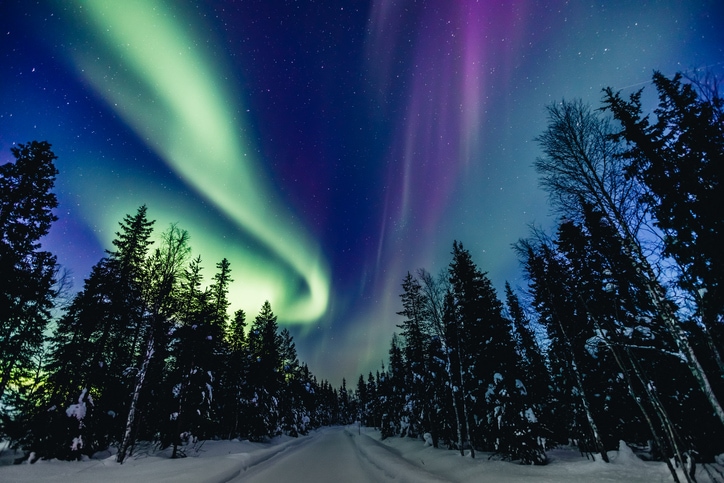Can Aurora Borealis Be Seen with the Naked Eye?
Experiencing the aurora borealis, or northern lights, is a dream for many travellers. This natural light display, predominantly seen in high-latitude regions around the Arctic and Antarctic, is a spectacle that leaves viewers in awe. But can you see the aurora borealis with the naked eye? Let’s delve into this fascinating topic.
Understanding the Aurora Borealis
The aurora borealis, commonly known as the northern lights, is a natural light display predominantly seen in high-latitude regions around the Arctic. This phenomenon occurs when charged particles from the sun collide with atoms in Earth’s atmosphere, causing bursts of light. These lights can appear in various colours, including green, pink, red, yellow, and blue, depending on the type of gas particles involved in the collisions.
While the aurora borealis can be captured in stunning detail with cameras, many wonder if these lights are visible to the naked eye. The answer is a resounding yes. However, several factors influence the visibility and intensity of this natural wonder.
Factors Affecting Its Visibility
Several factors can affect the visibility of the aurora borealis to the naked eye. These include:
- Geographical Location: The closer you are to the magnetic poles, the better your chances of seeing the northern lights. Lapland, particularly in areas like Saariselkä, offers some of the best opportunities for viewing.
- Time of Year: The aurora borealis can be seen year-round, but the best times are during the equinoxes in March and September. Winter months also offer extended periods of darkness, increasing the chances of sightings.
- Weather Conditions: Clear, dark skies are essential for optimal viewing. Cloud cover and light pollution can significantly diminish visibility.
- Solar Activity: The sun’s activity, which follows an 11-year cycle, affects the frequency and intensity of auroras. Higher solar activity results in more vibrant displays.
Best Locations to View the Aurora Borealis
For those eager to witness the northern lights, location is key. Finland, particularly Lapland, is one of the best-inhabited regions in the world for viewing the aurora borealis. Here are some prime locations:
- Saariselkä: Known for its pristine wilderness and minimal light pollution, Saariselkä offers excellent viewing opportunities. Our Villas are located here so we can arrange aurora hunting activities so you can see the lights.
- Ylläs and Levi: These ski resorts in Lapland provide not only winter sports but also a high probability of aurora sightings.
- Kilpisjärvi: Located in the far north, this area boasts a 75% chance of seeing the aurora on clear nights.
During geomagnetic storms, the auroral oval expands, making it possible to see the lights even in central and southern Finland. However, for the most consistent and vivid displays, northern Lapland remains unparalleled.
The Science Behind the Spectacle
The aurora borealis is a result of complex interactions between the sun and Earth’s magnetic field. When solar winds, composed of charged particles, reach Earth, they are directed by the planet’s magnetic field towards the poles. These particles then collide with gases in the atmosphere, such as oxygen and nitrogen, resulting in the emission of light.
The colours of the aurora depend on the type of gas and the altitude at which the collisions occur. For instance, oxygen at higher altitudes (above 150 miles) produces red auroras, while at lower altitudes (up to 60 miles), it emits green. Nitrogen, on the other hand, can produce blue or purplish-red auroras.
This scientific phenomenon is not only a visual delight but also a testament to the intricate workings of our solar system.
Best Practices for Viewing the Northern Lights
To maximise your chances of seeing the aurora borealis with the naked eye, consider the following tips:
- Dress Warmly: Northern regions can be extremely cold, especially at night. Layering your clothing and using hand warmers can keep you comfortable.
- Stay Informed: Check aurora forecasts and local weather conditions. Websites and apps can provide real-time updates on aurora activity.
- Find a Dark Spot: Avoid areas with light pollution. The darker the surroundings, the better the visibility.
- Be Patient: The aurora can be unpredictable. Sometimes, it may take hours of waiting before the lights appear.
- Use a Guide: Joining an aurora safari with an experienced local guide can enhance your experience. They know the best spots and can provide valuable insights.
At VALO Finland, we understand the allure of the northern lights and the desire to witness this natural wonder. Our luxury villas in Saariselkä offer the perfect base for your aurora adventures. With large picture windows, you can even enjoy the spectacle from the comfort of your villa. Additionally, we can assist in organising guided tours and other activities to ensure a memorable and immersive experience in Lapland.
In conclusion, the aurora borealis is indeed visible to the naked eye, provided the conditions are right. By understanding the factors that influence its visibility and following best practices, you can enhance your chances of witnessing this breathtaking phenomenon. Whether you’re a seasoned traveller or a first-time visitor, the magic of the northern lights awaits you in Lapland.
